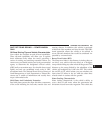
Crossing Large Rocks
When approaching large rocks, choose a path which
ensures you drive over the largest with your tires. This
will lift your undercarriage over the obstacle. The tread of
the tire is tougher and thicker than the side wall and is
designed to take the abuse. Always look ahead and make
every effort to cross the large rocks with your tires.
CAUTION!
•
Never attempt to straddle a rock that is large
enough to strike your axles or undercarriage.
•
Never attempt to drive over a rock which is large
enough to contact the door sills.
Crossing a Ravine, Gully, Ditch, Washout or Rut
When crossing a ravine, gully, ditch, washout or a large
rut, the angled approach is the key to maintaining your
vehicle’s mobility. Approach these obstacles at a 45-
degree angle and let each tire go through the obstacle
independently. You need to use caution when crossing
large obstacles with steep sides. Do not attempt to cross
any large obstacle with steep sides at an angle great
enough to put the vehicle at risk of a rollover. If you get
caught in a rut, dig a small trench to the right or left at a
45-degree angle ahead of the front tires. Use the removed
dirt to fill the rut ahead of the turnout you just created.
You should now be able to drive out following the trench
you just created at a 45-degree angle.
WARNING!
There is an increased risk of rollover when crossing
an obstacle, at any angle, with steep sides.
Crossing Logs
To cross a log, approach it at a slight angle (approxi-
mately 10 to 15 degrees). This allows one front tire to be
on top of the log while the other just starts to climb the
log. While climbing the log, modulate your brake and
348 STARTING AND OPERATING


















